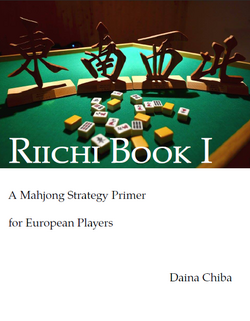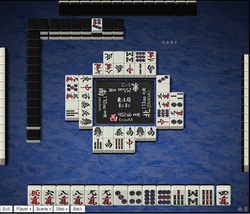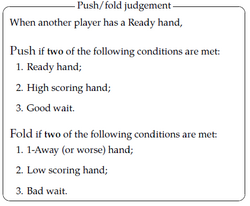Riichi Book 1: Difference between revisions
m (→Overview) |
|||
| Line 7: | Line 7: | ||
* [[Tenhou.net|Online riichi]] | * [[Tenhou.net|Online riichi]] | ||
* [[Tile efficiency]] | * [[Tile efficiency]] | ||
* [[Strategy]] | * [[Mahjong strategy|Strategy]] | ||
The bulk of the material covers the third item. | The bulk of the material covers the third item. | ||
Revision as of 08:39, 29 August 2020

Riichi Book 1 is a "mahjong strategy primer for European players". Written by Daina Chiba, it is a free online guide written in English and is often cited as go-to source for game improvement among the Western player base. The material is aimed to help players learn the game beyond yaku and perhaps attain tokujou level status on the Tenhou ladder.
Overview
The book is subdivided into three main sections:
The bulk of the material covers the third item.
Riichi online
The majority of this section points readers to Tenhou.net, as it was the most popular online site for riichi mahjong at the time of publication. To this day, it still is. However, the addition of Majsoul gives the platform some added competition. Though, Majsoul did not even exist at the time.
General strategies
The third section covers just under half of the book. The central issue stems on the decision to either push or fold. By push, this refers to continuing to build the hand to tenpai. Fold points generally points towards defense. A hand looking to push or fold looks at conditions regarding its value, wait pattern, and shanten state.
Tile efficiency

The third chapter of the book covers tile efficiency with an emphasis on maximization. Players need to understand that a hand can be broken down into basic blocks. Given various hand shapes, a hand during the process of development always have a number of waiting tiles to further progress the hand. Here, player must look to aim to reduce the shanten count. A lower shanten count reduces the number of waiting tiles. This only means the hand advances and requires fewer tiles to advance further. Once tenpai, the counts are minimized.
Tile groups
Tile groups can be broken down into two subcategories: sequential and triplets. Of the two, the former is the easier to complete by virtue of greater tile counts for completion. For every waiting pattern, there is a set number of waiting tiles. Ryanmen provide the greatest number of waiting tiles from using just two tiles. As for other shapes, players may need to consider the ability for the tile shape to be reformed. During the formation of a hand, players may upgrade isolated tiles into taatsu.
Tile versatility
Certain tiles are more versatile than others. This is due to the number ranges.
Tile closer to the terminals have fewer tiles, that can help improve the shape. Tiles 3-7 each can form taatsu using four tile types. Tiles 2 and 8 are reduced to needing any of three tile types. Terminals are limited to just two tile types in order to develop. The honor tiles are the most difficult as they are each reduced to their own type.
Furthermore, kanchan waits can be ordered by versatility. This stems from their ability to be reshaped and upgraded into ryanmen.
Pairs
All hands require paired tiles for completion. Then there is chiitoitsu, which is a collection of pairs. If a developing hand lacks a pair, then logically, the hand needs one. Of course, a hand could be tenpai on the pair, or tanki. However, as a wait, it is not an ideal one. If possible, a hand can be improved with a specific draw even when tenpai to produce a waiting pattern with a greater range to tile types.
The pair is a taatsu. Like any, they can be upgraded. In this case, a pair can become a triplet. Pairs are not often ideal, especially when more than one is in the hand. The weakest count of pairs falls on three, as efficiency gets hindered by the lower number of waiting tiles. A hand with four pairs at least has chiitoitsu as a consideration.
Perfect shanten
Hands have perfect shanten when they have multiple options to attain shanten reduction, including getting to tenpai. The options include calling chii, pon, or drawing tiles to complete the necessary groups and advance shanten. Finally, the hand always has the ability to produce the wait of ryanmen.
Scoring
It is suggested to know the projected value of the hand, even before winning it. Naturally, this is only possible with the familiarity of the game's complicated scoring system. Score based decisions factor into various game decisions. This subsection breaks down the different components to knowing hand scores as well as some short cuts. Overall, it takes practice to learn the scoring table enough, to utilize for in-game decision making.
Riichi
Riichi is a central element to the game, where players have the option to call or not to call. Many cases point towards calling riichi immediately, or "insta-riichi". Here, the decision to call riichi comes with little to no hesitation. Yet, other cases depend on the game state, which includes the score situation, potential hand value, and the current hand.
Defense
Players look for tiles for defensive purposes.
The natural selection aims at genbutsu tiles and then suji tiles.
Then kabe plays a part, where discarded tiles may form a "blockade". Numbered tiles discarded form blockades along different suji intervals, making the formation of specific ryanmen patterns either difficult or impossible.
Open calls
Given the proper tiles, players have the ability to call on tiles and open the hand. In many cases, hands devalue once opened. Most rule sets include kuitan, or open tanyao. Often enough, players may be tempted to push for this hand regardless of value.
Many players open hands in order to push for either a fast and/or expensive hand. It becomes problematic when the open call leans towards a slow and cheap hand. The slow hand is reflected by a three shanten hand with bad waits.
As noted, open calls can reduce a hand's value. In many cases, the option to build a closed hand for riichi may be the much better alternative. However, if a hand's value can be maintained while open, then an open hand may be the more favorable option.
Other tile call situations may stem on improving the wait. A drawn tile can help improve the wait of a hand. Likewise, a discarded tile can do the same. Thus, a tile call can be used to alter the shape of the hand in order to create a more favorable wait.
Sometimes, certain calls are necessary in order to complete yaku. In these cases, the tile call may serve as a means to attain tenpai at all.
The push and fold decision

One of the most difficult aspects of the game rests on the decision to either push or fold. In other words, this decision looks to either be offensive or defensive. When playing offensively, the hand must show its worth either in terms of value or readiness. Otherwise, the hand simply cannot fight and therefore must fold.
Furthermore, players must take into account opponent readiness. This generally takes some guess work and is extremely dificult. If players are not tenpai, then defensive play is not all that necessary. Of course, if another player declares riichi, then the decision to fold becomes easier.
Finally, the current point standing plays into the push fold decision. Players in the lead are not as pressured to push, as those who are not. Players sitting in fourth, especially in the latter South round hands are more inclined to push at almost any cost. The result for players not to push or dealing in may be the same, if placement is the only criteria.
South 4
South 4, or "all last", is typically the last hand of the game. This is barring renchan. Many mahjong rule sets, particularly tournament, apply a calculation of uma, which is a point bonus applied to placement.
In this last rotation, players must take note of point differences. For non-dealers, this is effectively the game's last hand. When scoring a hand, the player must take note of the point difference via both ron and tsumo. From there, the hand must be built to fit the point requirement to make up the difference for gyakuten.
South 3
South 3 effectively marks only two hands remaining in a game, barring renchan.
Etiquette
While included in the third section, this portion of the book warrants some importance, as mahjong players are suggested to learn some game etiquette. Etiquette aids in game functionality, by prompting players to not waste time. A single hanchan can take roughly anywhere between one hour to ninety minutes, depending on the average player speed.
External links
Sources
Daina Chiba cited multiple sources to produce this book, including this Wiki.